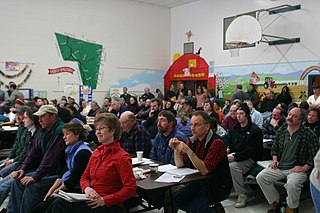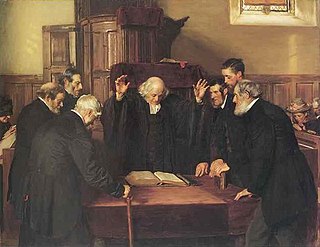See also
- Parochial church council – an executive body all Church of England parishes have
- Vestry – the parish vestry meeting
The annual meeting of parishioners (also referred to as the annual vestry meeting) is held yearly in every parish of the Church of England to elect churchwardens and deputies (if any) for the forthcoming year. The meeting must be held by 31 May [1] and is commonly held immediately prior to the annual meeting of the parochial church council. It is the last remnant of the old vestry meeting.
Since this is a public meeting, notice must be given in writing with the minimum period of two Sundays before the date of the meeting and the notice must be displayed publicly.
The meeting is convened and chaired by the minister (usually the incumbent or priest-in-charge), or if there is no minister or if she or he is unable or unwilling to chair the meeting, the churchwardens convene, and the meeting elects a chairman.
Typically, the meeting's structure is as follows:
As the agenda is so short, meetings typically last less than ten minutes.
The following people may vote: [2]
A parish is a territorial entity in many Christian denominations, constituting a division within a diocese. A parish is under the pastoral care and clerical jurisdiction of a priest, often termed a parish priest, who might be assisted by one or more curates, and who operates from a parish church. Historically, a parish often covered the same geographical area as a manor. Its association with the parish church remains paramount.

Parish councils are civil local authorities found in England which are the lowest tier of local government. They are elected corporate bodies, with variable tax raising powers, and they carry out beneficial public activities in geographical areas known as civil parishes. There are about 9,000 parish and town councils in England, and over 16 million people live in communities served by them. Parish councils may be known by different styles, they may resolve to call themselves a town council, village council, community council, neighbourhood council, or if the parish has city status, it may call itself a city council. However their powers and duties are the same whatever name they carry.

A town meeting is a form of direct democracy in which most or all of the members of a community come together to legislate policy and budgets for local government. It is a town- or city-level meeting in which decisions are made, in contrast with town hall meetings held by state and national politicians to answer questions from their constituents, which have no decision-making power.

In England, a civil parish is a type of administrative parish used for local government. It is a territorial designation which is the lowest tier of local government below districts and counties, or their combined form, the unitary authority. Civil parishes can trace their origin to the ancient system of ecclesiastical parishes which historically played a role in both secular and religious administration; civil and religious parishes were formally differentiated in the 19th century and are now entirely separate. Civil parishes in their modern form came into being through the Local Government Act 1894, which established elected parish councils to take on the secular functions of the parish vestry.

In Christianity, a collegiate church is a church where the daily office of worship is maintained by a college of canons: a non-monastic or "secular" community of clergy, organised as a self-governing corporate body, which may be presided over by a dean or provost. In its governance and religious observance a collegiate church is similar to a cathedral, although a collegiate church is not the seat of a bishop and has no diocesan responsibilities. Collegiate churches were often supported by extensive lands held by the church, or by tithe income from appropriated benefices. They commonly provide distinct spaces for congregational worship and for the choir offices of their clerical community.
A parochial church council (PCC) is the executive committee of a Church of England parish and consists of clergy and churchwardens of the parish, together with representatives of the laity. It has its origins in the vestry committee, which looked after both religious and secular matters in a parish. It is a corporate charitable body.
A churchwarden is a lay official in a parish or congregation of the Anglican Communion, usually working as a part-time volunteer. Holders of these positions are ex officio members of the parish board, usually called a vestry, parochial church council, or in the case of a Cathedral parish the chapter.
A vestry was a committee for the local secular and ecclesiastical government for a parish in England, Wales and some English colonies which originally met in the vestry or sacristy of the parish church, and consequently became known colloquially as the "vestry".
A parish meeting, in England, is a meeting to which all the electors in a civil parish are entitled to attend.

A Church of Scotland congregation is led by its minister and elders. Both of these terms are also used in other Christian denominations: see Minister (Christianity) and Elder (Christianity). This article discusses the specific understanding of their roles and functions in the Scottish Church.
A sidesman, also known as a sidesperson, usher or Assistant Churchwarden, in the Anglican Church is responsible for greeting members of the congregation, overseeing seating arrangements in church, making the congregation queue for communion at the altar in an orderly way, and for taking the collection. In England they are usually appointed by the Annual Parochial Church Meeting and receive guidance in their duties from the churchwardens.
A bill for the better regulating of Select Vestries, usually referred to as the Select Vestries Bill, is customarily the first bill introduced and debated in the United Kingdom's House of Lords at the start of each session of Parliament. The equivalent bill used by the House of Commons is the Outlawries Bill.
The church rate was a tax formerly levied in each parish in England and Ireland for the benefit of the parish church. The rates were used to meet the costs of carrying on divine service, repairing the fabric of the church and paying the salaries of the connected officials.

In the Roman Catholic Church and the Anglican Communion as well as some Lutheran denominations, a rural dean is a member of clergy who presides over a "rural deanery" ; "ruridecanal" is the corresponding adjective. In some Church of England dioceses rural deans have been formally renamed as area deans.

St Stephen's Church in St Stephen's Avenue, is the parish church for the city of Bristol, England.

SS Philip and Jacob Church, previously referred to as Pip 'n' Jay, is a parish church in central Bristol, England. The church that meets there is now called Central. Its full name since 1934 is St Philip and St Jacob with Emmanuel the Unity, although reference to the original church of St Philip exists in records dating from 1174. Historically the 'Mother church of East Bristol', it serves the area known as The Dings.
The Church of St. Thomas of Canterbury is an active Anglican parish church situated in the City of Chester, in an area of the city informally known as "The Garden Quarter", a densely populated area, close to the University. The church was built in 1872, but the parish of St. Oswald which it serves is much older, dating back to about 980 AD. One of the earliest references to St. Oswald's can be found in Bradshaw's. The parish registers date back to 1580. The church is recorded in the National Heritage List for England as a designated Grade II listed building. The church is part of the diocese of Chester, the archdeaconry of Chester and the deanery of Chester. The patrons of the parish are the dean and chapter of Chester Cathedral.

St. Thomas Episcopal Church is an historic church at 115 High Street in Taunton, Massachusetts, United States. Its present building, an 1857 Gothic Revival structure designed by Richard Upjohn, is listed on the National Register of Historic Places.

The parish with its parish church(es) is the basic territorial unit of the Church of England. The parish has its roots in the Roman Catholic Church and survived the English Reformation largely untouched. Each is within one of 42 dioceses: divided between the thirty of the Canterbury and the twelve of that of York. There are around 12,500 Church of England parishes.
Jonas Pilling was vicar of the former Church of St Mark, Old Leeds Road, Huddersfield, West Yorkshire, England, from 1905 to 1926. He was the notorious subject of many newspaper articles about the fourteen-year dispute between Pilling and his congregation, the absence of churchwardens, other officials and choir, the dwindling of his congregation and the dereliction of the church building. This occurred in an industrial environment of great poverty, where there was "plenty of scope for church work." At the 1921 Bishop's Commission, he mentioned his fear of "plottings."